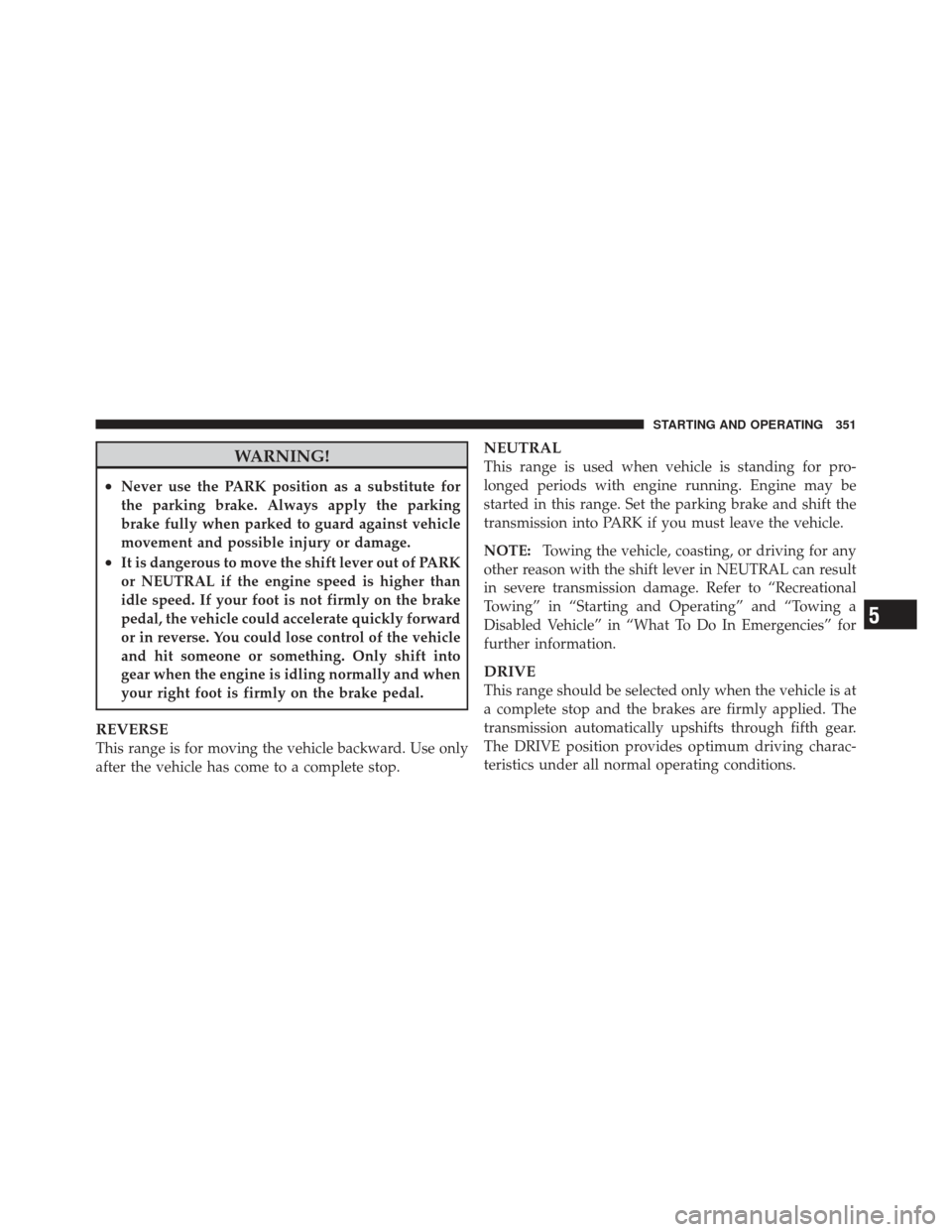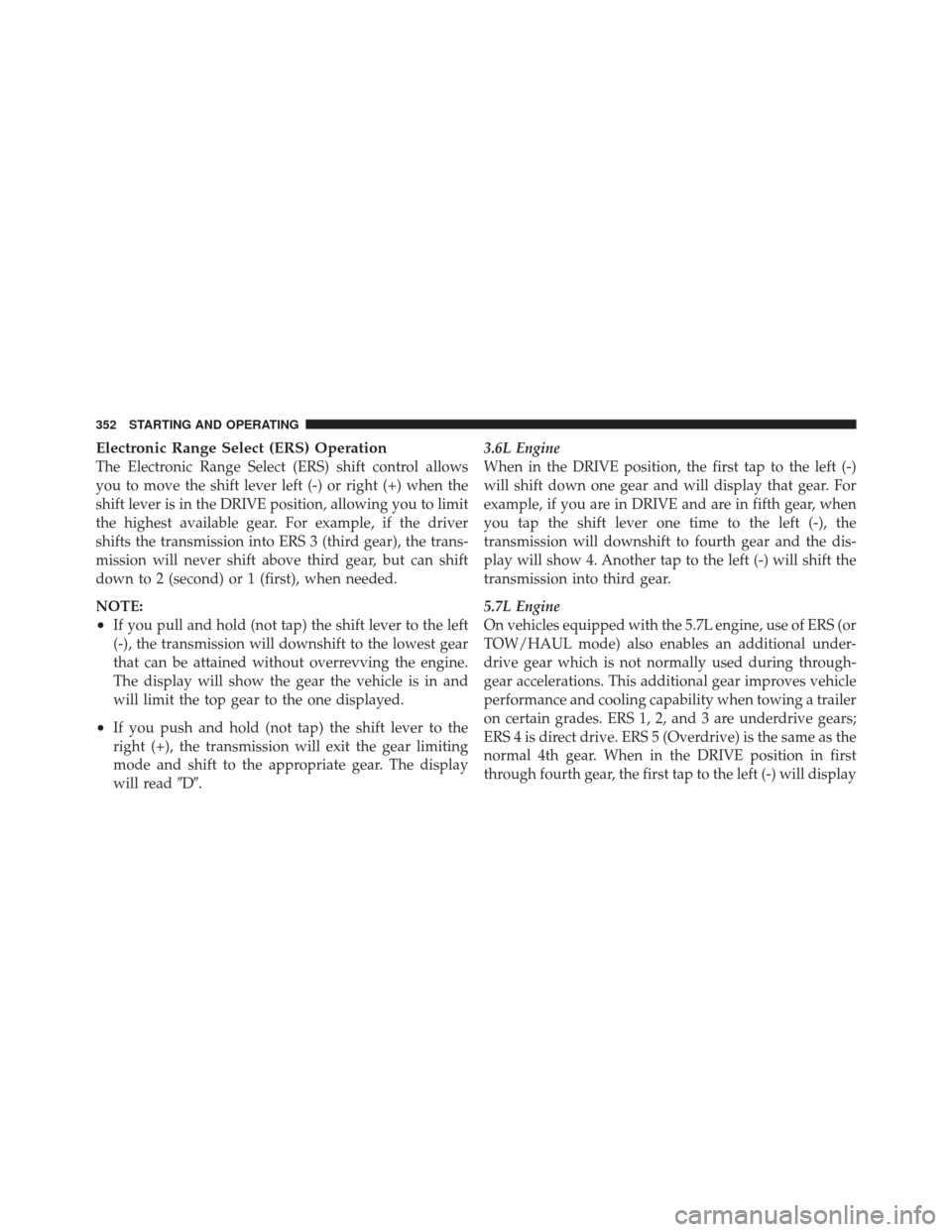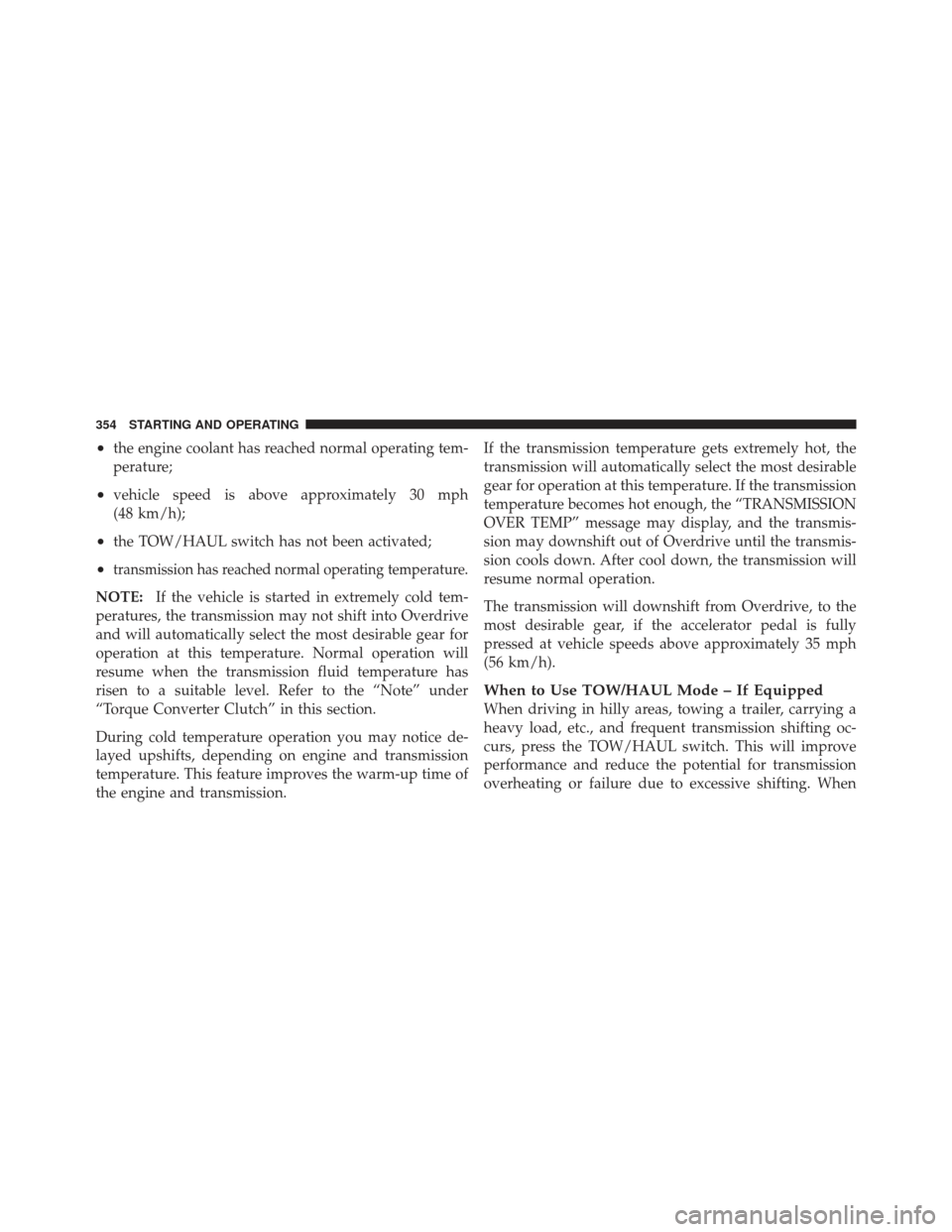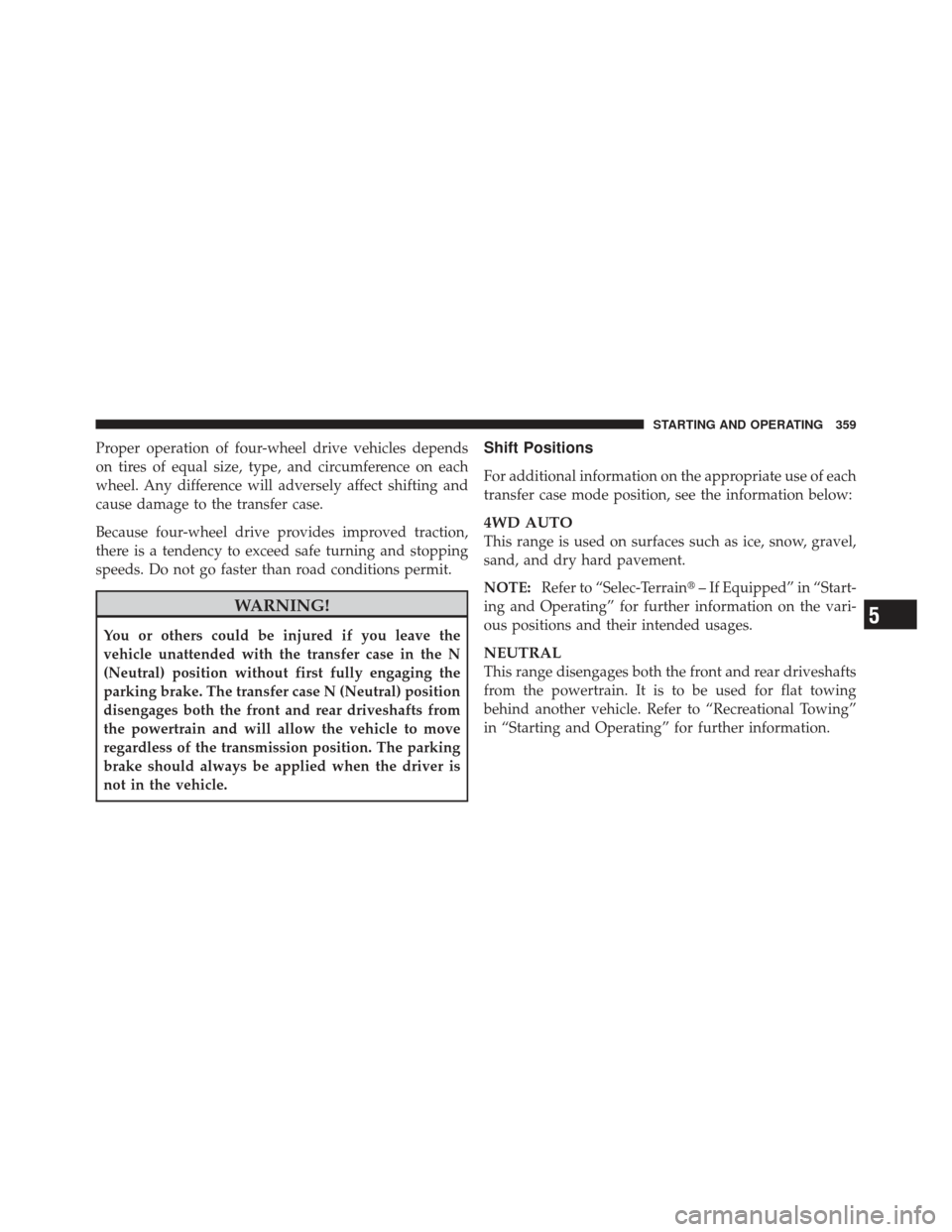Page 343 of 587

▫Carbon Monoxide Warnings ............ 428
� Flexible Fuel (3.6L Engine Only) —
If Equipped .......................... 429
▫ E-85 General Information ............... 429
▫ Ethanol Fuel (E-85) ................... 430
▫ Fuel Requirements ................... 430
▫ Selection Of Engine Oil For Flexible Fuel
Vehicles (E-85) And Gasoline Vehicles ...... 431
▫ Starting ........................... 432
▫ Cruising Range ...................... 432
▫ Replacement Parts ................... 432
▫ Maintenance ........................ 432 �
Adding Fuel ......................... 433
▫ Fuel Filler Cap (Gas Cap) .............. 433
▫ Loose Fuel Filler Cap Message ........... 436
� Vehicle Loading ...................... 436
▫ Certification Label ................... 436
� Trailer Towing ........................ 438
▫ Common Towing Definitions ............ 439
▫ Trailer Hitch Classification .............. 443
▫ Trailer Towing Weights
(Maximum Trailer Weight Ratings) ........ 444
▫ Trailer And Tongue Weight ............. 445
▫ Towing Requirements ................. 446
▫ Towing Tips ........................ 451
5
STARTING AND OPERATING 341
Page 344 of 587
�Snow Plow .......................... 452
� Recreational Towing
(Behind Motorhome, Etc.) ................ 453
▫ Towing This Vehicle Behind
Another Vehicle ..................... 453
▫ Recreational Towing — Two-Wheel Drive
Models ........................... 454 ▫
Recreational Towing — Quadra-Trac I�
(Single-Speed Transfer Case) Four-Wheel
Drive Models ....................... 454
▫ Recreational Towing — Quadra–
Trac II� /Quadra–Drive� II Four-Wheel
Drive Models ....................... 455
342 STARTING AND OPERATING
Page 353 of 587

WARNING!
•Never use the PARK position as a substitute for
the parking brake. Always apply the parking
brake fully when parked to guard against vehicle
movement and possible injury or damage.
•It is dangerous to move the shift lever out of PARK
or NEUTRAL if the engine speed is higher than
idle speed. If your foot is not firmly on the brake
pedal, the vehicle could accelerate quickly forward
or in reverse. You could lose control of the vehicle
and hit someone or something. Only shift into
gear when the engine is idling normally and when
your right foot is firmly on the brake pedal.
REVERSE
This range is for moving the vehicle backward. Use only
after the vehicle has come to a complete stop.
NEUTRAL
This range is used when vehicle is standing for pro-
longed periods with engine running. Engine may be
started in this range. Set the parking brake and shift the
transmission into PARK if you must leave the vehicle.
NOTE:Towing the vehicle, coasting, or driving for any
other reason with the shift lever in NEUTRAL can result
in severe transmission damage. Refer to “Recreational
Towing” in “Starting and Operating” and “Towing a
Disabled Vehicle” in “What To Do In Emergencies” for
further information.
DRIVE
This range should be selected only when the vehicle is at
a complete stop and the brakes are firmly applied. The
transmission automatically upshifts through fifth gear.
The DRIVE position provides optimum driving charac-
teristics under all normal operating conditions.
5
STARTING AND OPERATING 351
Page 354 of 587

Electronic Range Select (ERS) Operation
The Electronic Range Select (ERS) shift control allows
you to move the shift lever left (-) or right (+) when the
shift lever is in the DRIVE position, allowing you to limit
the highest available gear. For example, if the driver
shifts the transmission into ERS 3 (third gear), the trans-
mission will never shift above third gear, but can shift
down to 2 (second) or 1 (first), when needed.
NOTE:
•If you pull and hold (not tap) the shift lever to the left
(-), the transmission will downshift to the lowest gear
that can be attained without overrevving the engine.
The display will show the gear the vehicle is in and
will limit the top gear to the one displayed.
•If you push and hold (not tap) the shift lever to the
right (+), the transmission will exit the gear limiting
mode and shift to the appropriate gear. The display
will read�D�. 3.6L Engine
When in the DRIVE position, the first tap to the left (-)
will shift down one gear and will display that gear. For
example, if you are in DRIVE and are in fifth gear, when
you tap the shift lever one time to the left (-), the
transmission will downshift to fourth gear and the dis-
play will show 4. Another tap to the left (-) will shift the
transmission into third gear.
5.7L Engine
On vehicles equipped with the 5.7L engine, use of ERS (or
TOW/HAUL mode) also enables an additional under-
drive gear which is not normally used during through-
gear accelerations. This additional gear improves vehicle
performance and cooling capability when towing a trailer
on certain grades. ERS 1, 2, and 3 are underdrive gears;
ERS 4 is direct drive. ERS 5 (Overdrive) is the same as the
normal 4th gear. When in the DRIVE position in first
through fourth gear, the first tap to the left (-) will display
352 STARTING AND OPERATING
Page 356 of 587

•the engine coolant has reached normal operating tem-
perature;
•vehicle speed is above approximately 30 mph
(48 km/h);
•the TOW/HAUL switch has not been activated;
•transmission has reached normal operating temperature.
NOTE:If the vehicle is started in extremely cold tem-
peratures, the transmission may not shift into Overdrive
and will automatically select the most desirable gear for
operation at this temperature. Normal operation will
resume when the transmission fluid temperature has
risen to a suitable level. Refer to the “Note” under
“Torque Converter Clutch” in this section.
During cold temperature operation you may notice de-
layed upshifts, depending on engine and transmission
temperature. This feature improves the warm-up time of
the engine and transmission. If the transmission temperature gets extremely hot, the
transmission will automatically select the most desirable
gear for operation at this temperature. If the transmission
temperature becomes hot enough, the “TRANSMISSION
OVER TEMP” message may display, and the transmis-
sion may downshift out of Overdrive until the transmis-
sion cools down. After cool down, the transmission will
resume normal operation.
The transmission will downshift from Overdrive, to the
most desirable gear, if the accelerator pedal is fully
pressed at vehicle speeds above approximately 35 mph
(56 km/h).
When to Use TOW/HAUL Mode – If Equipped
When driving in hilly areas, towing a trailer, carrying a
heavy load, etc., and frequent transmission shifting oc-
curs, press the TOW/HAUL switch. This will improve
performance and reduce the potential for transmission
overheating or failure due to excessive shifting. When
354 STARTING AND OPERATING
Page 361 of 587

Proper operation of four-wheel drive vehicles depends
on tires of equal size, type, and circumference on each
wheel. Any difference will adversely affect shifting and
cause damage to the transfer case.
Because four-wheel drive provides improved traction,
there is a tendency to exceed safe turning and stopping
speeds. Do not go faster than road conditions permit.
WARNING!
You or others could be injured if you leave the
vehicle unattended with the transfer case in the N
(Neutral) position without first fully engaging the
parking brake. The transfer case N (Neutral) position
disengages both the front and rear driveshafts from
the powertrain and will allow the vehicle to move
regardless of the transmission position. The parking
brake should always be applied when the driver is
not in the vehicle.
Shift Positions
For additional information on the appropriate use of each
transfer case mode position, see the information below:
4WD AUTO
This range is used on surfaces such as ice, snow, gravel,
sand, and dry hard pavement.
NOTE:Refer to “Selec-Terrain� – If Equipped” in “Start-
ing and Operating” for further information on the vari-
ous positions and their intended usages.
NEUTRAL
This range disengages both the front and rear driveshafts
from the powertrain. It is to be used for flat towing
behind another vehicle. Refer to “Recreational Towing”
in “Starting and Operating” for further information.
5
STARTING AND OPERATING 359
Page 389 of 587

Trailer Sway Control (TSC)
TSC uses sensors in the vehicle to recognize an exces-
sively swaying trailer and will take the appropriate
actions to attempt to stop the sway. The system may
reduce engine power and apply the brake of the appro-
priate wheel(s) to counteract the sway of the trailer. TSC
will become active automatically once an excessively
swaying trailer is recognized. No driver action is re-
quired. Note that TSC cannot stop all trailers from
swaying. Always use caution when towing a trailer and
follow the trailer tongue weight recommendations. Refer
to “Trailer Towing” in “Starting and Operating” for
further information. When TSC is functioning, the “ESC
Activation/Malfunction Indicator Light” will flash, the
engine power may be reduced and you may feel the
brakes being applied to individual wheels to attempt to
stop the trailer from swaying. TSC is disabled when the
ESC system is in the “Partial Off” mode.WARNING!
If TSC activates while driving, slow the vehicle
down, stop at the nearest safe location, and adjust the
trailer load to eliminate trailer sway.
Hill Start Assist (HSA)
The HSA system is designed to assist the driver when
starting a vehicle from a stop on a hill. HSA will maintain
the level of brake pressure the driver applied for a short
period of time after the driver takes their foot off of the
brake pedal. If the driver does not apply the throttle
during this short period of time, the system will release
brake pressure and the vehicle will roll down the hill. The
system will release brake pressure in proportion to the
amount of throttle applied as the vehicle starts to move in
the intended direction of travel.
5
STARTING AND OPERATING 387
Page 390 of 587
HSA Activation Criteria
The following criteria must be met in order for HSA to
activate:
•Vehicle must be stopped.
•Vehicle must be on a 6% (approximate) grade or
greater hill.
•Gear selection matches vehicle uphill direction (i.e.,
vehicle facing uphill is in forward gear; vehicle back-
ing uphill is in REVERSE gear).
HSA will work in REVERSE and all forward gears when
the activation criteria have been met. The system will not
activate if the vehicle is placed in NEUTRAL or PARK.
WARNING!
There may be situations on minor hills (i.e., less than
8%), with a loaded vehicle, or while pulling a trailer,
when the system will not activate and slight rolling
may occur. This could cause a collision with another
vehicle or object. Always remember the driver is
responsible for braking the vehicle.
Towing With HSA
HSA will provide assistance when starting on a grade
when pulling a trailer.
388 STARTING AND OPERATING